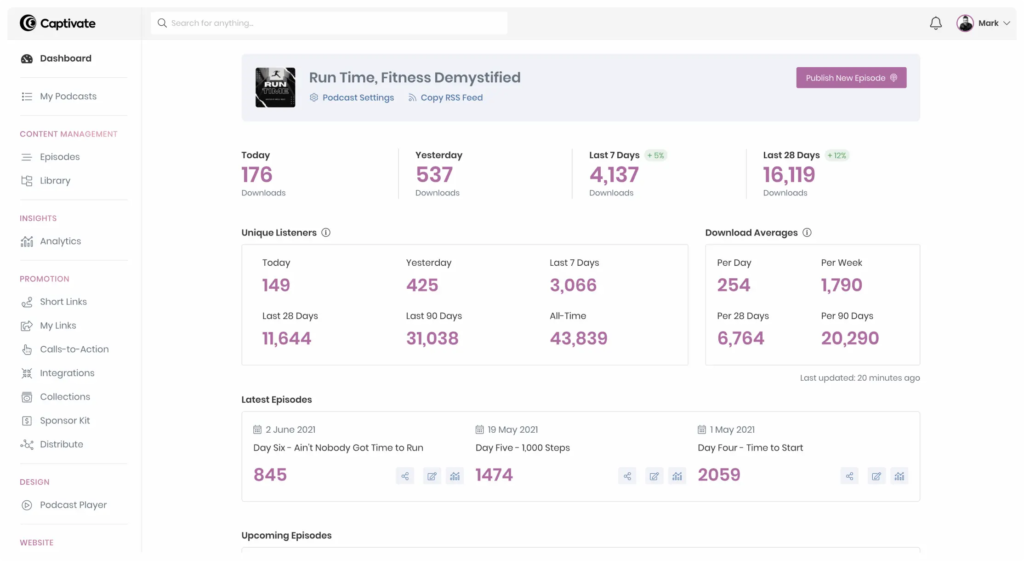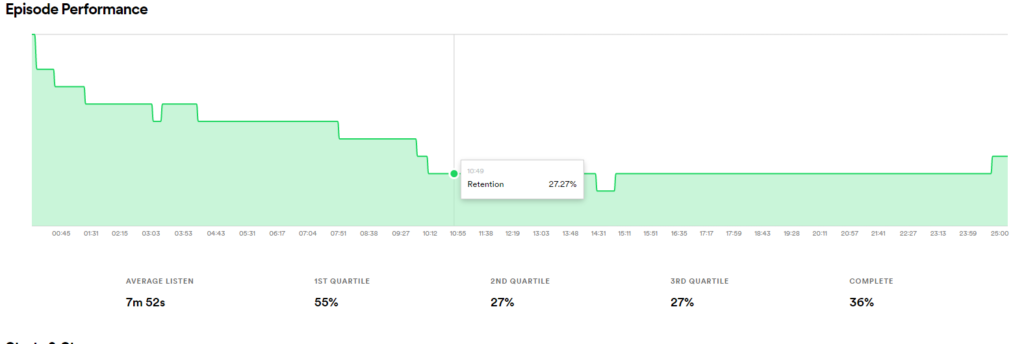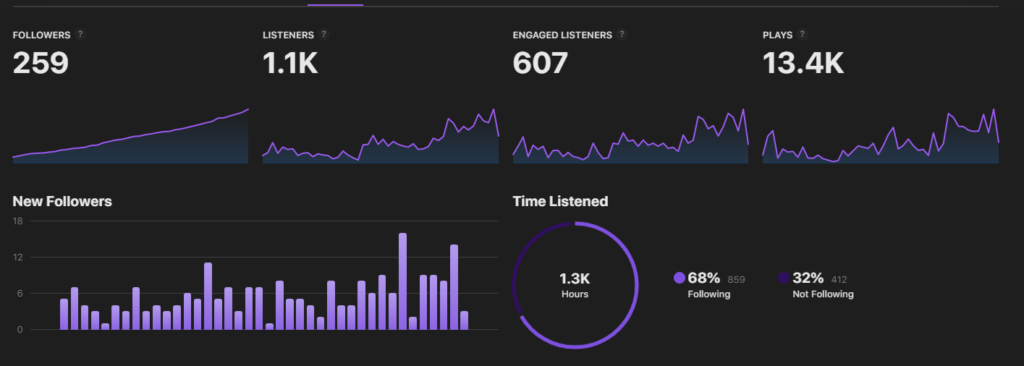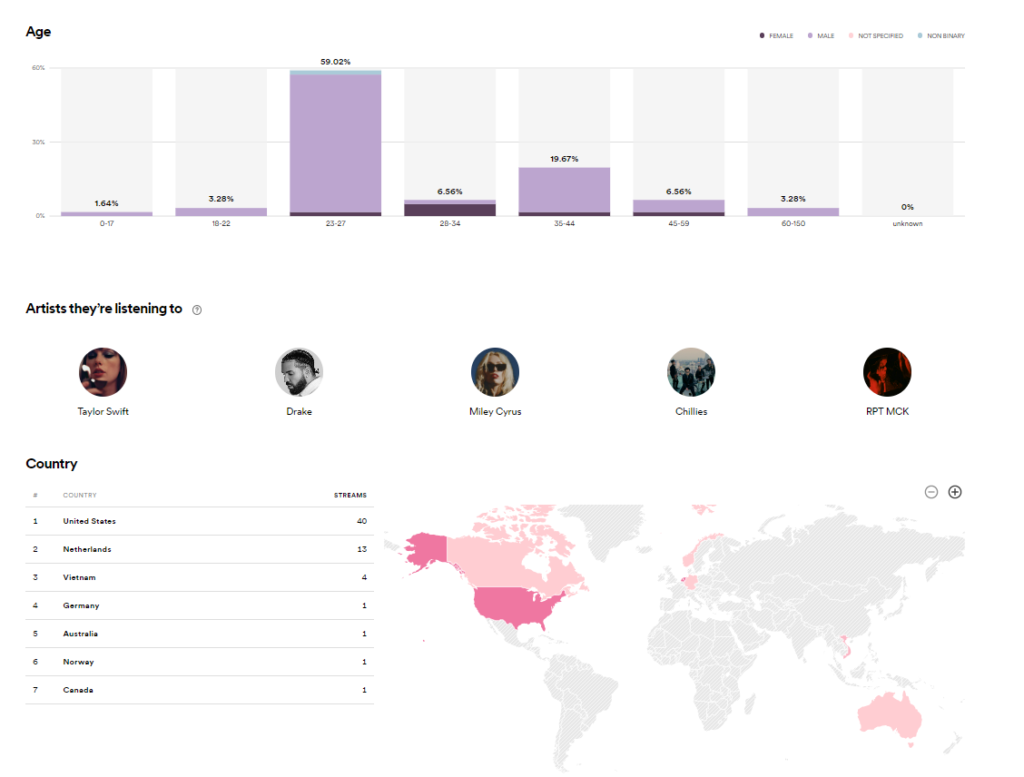As a podcaster, it’s important to understand the metrics that can help you measure the success of your show.
From the number of downloads and plays to listener retention and engagement, there are a variety of metrics that can provide valuable insights into your podcast listeners and help you grow your show. But with so many different metrics available, it can be overwhelming to know which ones to focus on, how to interpret them, and how to use them to make your podcast a success. That’s where this post comes in.
I’ll be exploring the different types of podcast metrics, how to track them, and what they can tell you about your listeners. We’ll also be discussing some of the common misconceptions around podcast metrics and how to avoid falling into these traps.
So whether you’re a new podcaster just starting or a seasoned pro looking to take your show to the next level, this blog is for you. Get ready to learn all about podcast metrics and how to use them to make your podcast successful!
Related Article: How To Start A Podcast In 2023

Contents
Downloads v Listens
Before we get started, there is often some confusion with the terms downloads and listens.
These can be used interchangeably. Downloads hark back to the early days of podcasts before streaming was prevalent. To listen to a podcast you would have to download it onto your iPod. If you’re asking what is an iPod then I feel very, very old. But this is where the name podcast comes from! iPod and Broadcast!
So whether someone downloads your podcast or listens to it on a streaming platform it is counted as the same thing by your podcast host.
For this blog post, I will use both of these interchangeably.

So Why Is Podcast Data So Important?
I know talking about numbers and data can be boring, but trust me, when it comes to podcasting, analytics are your best friend!
First of all, podcast analytics can help you understand your audience better. By looking at data like the number of listeners, listener retention, and location, you can figure out who is listening to your podcast and where. This information can help you tailor your content to better meet the needs and interests of your listeners. Or how to market your show.
The data will also show you the different devices that people are using to listen. If most people use an Apple mobile device to listen to the Apple Podcasts app, then share the Apple Podcasts link or make sure the Apple Podcasts link is the number 1 link on your social media posts and all embedded players on your website. You could even run an Ad on Facebook that only targets users of iPhones for ultra-targetted advertising!
Secondly, podcast analytics can help you measure podcast success. It’s important to know how your podcast is performing, what’s working, and what’s not. By tracking data like listens, and engagement, you can figure out which episodes are resonating with your listeners and what you can do to improve future episodes.
And finally, podcast analytics can also help you attract relevant sponsors and advertisers. Sponsors want to see that you have an engaged and growing audience, and analytics can provide you with the data to prove that. The more you know about your audience, the easier it will be to pitch your podcast to the relevant sponsors.
Podcast analytics are essential if you want to grow your show and make it successful. And remember, don’t be afraid of the numbers – embrace them!
Find out how to engage your audience: Best Conversational Podcasts in 2022 That Make You Laugh And Think

Types Of Podcast Analytics
Now let’s talk about the different types of podcast analytics!
First up, we have basic analytics. This includes things like how many podcast listeners you have and downloads per episode. It’s a great way to get a general idea of how your podcast performance for each podcast episode and overall. Check the metrics of a new episode over the first 7 days. This is essential to measure listener growth and your podcast’s performance.
For your first episode don’t put too much weight on these numbers. Many podcasters will see their show grow over time. If you post consistently new episodes will see an increase in audience members.
Next, we have engagement metrics. This includes things like average listening time, completion rate, and user retention. These metrics can help you understand if your audience is engaging with your podcast content and how much of an episode they listen to.
Third, we have demographic metrics. This type of analytics can give you insight into who is listening to your podcast. This includes things like age, gender, location, and interests. Understanding your podcast demographics can help you create more targeted and effective podcast content.
Finally, we have conversion metrics. This type of analytics tracks how many listeners are taking action based on your podcast. This includes things like website visits, purchases, and email sign-ups. It can help you understand how your podcast is impacting your overall business goals.
Related Article: How To Write Podcast Show Notes That Engages Listeners

How To Track Podcast Analytics
Tracking your podcast analytics is an essential part of understanding your audience and measuring your podcast’s success.
First things first, make sure you read your analytics! All the podcast hosting platforms will show you a similar but slightly different way to measure podcast performance.
There are also options out there that you can pay for like Podtrac or Chartable. These tools will give you valuable insights into your audience demographics, listening habits, and more.

Next, pay attention to your download numbers. This is one of the most basic and important metrics to track, as it tells you how many people are listening to your show. But don’t stop there!
But, your download numbers don’t mean anything if the retention for your episodes is in the toilet. Retention measures “How Much” of an episode your audience listens to or consumes. This is where you need to focus your attention because of its insight into your podcast and your audience.
And it is one of the metrics that Apple looks at when ranking your podcast in the charts. This is one metric that differs wildly from YouTube. Whereas Podcasts tend to have lower download numbers they can have an average consumption of around 80%. YouTube is 50% or lower.
So track your listener retention rate, which tells you how many people are sticking around to listen to the whole episode.


Your host platform can’t tell you this data as you must find it from each platform.
The two main ones are Spotify and Apple Podcasts so log into each of your accounts and you can find this metric.
Spotify for Podcasters will tell you All-time Plays, the average plays per episode, Audience size (how many people played an episode of my podcast in the last week), and Spotify followers. And if you delve a little deeper into the median playtime, which is the point in the episode where 50% of the people who started were still streaming.
While Apple Podcasts will tell you your followers on the platform, listeners (How many people played an episode of my podcast in the last week), engaged listeners (the number of unique devices that played at least 20 minutes or 40% of an episode within a single session. Pausing or stopping an episode does not count as starting a new session.) and Plays (The number of plays on unique devices where the play duration is greater than 0 seconds.) and average consumption (How much of an episode is consumed by listeners, on average.)

Phew! You can see how exhausting it can be to analyze your metrics because no platform gives you the same metrics.
Focus on the downloads and the consumption of each episode before your brain explodes over-analyzing the data. Another important metric to track is your overall audience engagement rate. This includes things like social media shares, comments, and ratings/reviews. The more engaged your audience is, the more likely they are to become loyal fans and spread the word about your show.
And finally, don’t forget to experiment and try new things! Use your analytics to see what’s working and what’s not, and adjust your strategy accordingly. The more you learn about your audience, the better you’ll be able to serve them with high-quality content they’ll love.
Remember, it’s not just about the numbers – it’s about understanding your audience and creating a better show for them.
Related Article: How To Make Your Podcast Conversational So People ACTUALLY listen

Interpreting Podcast Analytics
So, you’ve got all these numbers and graphs staring back at you from your podcast analytics dashboard, but what does it all mean? Don’t worry, it’s not as daunting as it looks.
First things first, let’s talk about your audience. Look at your listener demographics – age, gender, location, and device used. This will give you a better idea of who your listeners are and what they’re interested in.
Next, take a look at your episode performance. Which episodes are getting the most listens? Are there any patterns? Are there certain topics that seem to resonate more with your audience? Use this information to guide your content strategy moving forward.
Another important metric is engagement. Look at things like the average listen duration and the percentage of listeners who are listening through your episodes. This will give you an idea of how engaged your audience is and whether they’re really connecting with your content.
Finally, don’t forget to track your growth over time. Are you gaining more listeners with each episode? Is your audience growing in certain locations or on certain platforms? Use this information to make informed decisions about how to promote and market your podcast.
Remember, interpreting podcast analytics is all about using the data to guide your decision-making and content strategy. Don’t get too caught up in the numbers – at the end of the day, it’s all about creating great content that resonates with your audience.
Want to become a podcast editor? Find out how!

Metrics For Measuring Success
Now that you know how to track and interpret podcast analytics, it’s time to focus on the metrics that truly matter for measuring success.
First up, we have the number of downloads, which is a great indicator of your show’s overall popularity. Next, we have the number of unique listeners, which helps you understand how many people are tuning in to your show regularly.
Then we have the average listening time, which shows you how engaged your listeners are with your content. If people are listening to your episodes all the way through, you’re definitely on the right track.
Another important metric is subscriber growth, which indicates how quickly your audience is growing over time. And last but not least, we have audience demographics, which gives you a better understanding of who your listeners are and how to tailor your content to their preferences.
So there you have it! Keep an eye on these key metrics and you’ll be well on your way to measuring success in the world of podcasting.

Here are some best practices to help you get started:
- Consistency is key – try to release episodes on a regular schedule to keep your audience engaged.
- Promote your podcast on social media and other platforms to reach a wider audience.
- Encourage listeners to leave reviews and ratings on platforms like Apple Podcasts, which can boost your visibility.
- Ask for and pay attention to listener feedback and adjust your content accordingly.
- Use episode titles and descriptions that accurately reflect the content, so that potential listeners can find you more easily.
Remember, it’s important to continually monitor your analytics to track your progress and make informed decisions about how to improve. With some hard work and dedication, you can grow your audience and create a successful podcast!
Strategies
There are a few strategies you can try to keep people listening to your podcast for longer
- Hook your listeners early: Start your episode with a compelling introduction that captures your listeners’ attention and entices them to keep listening.
- Keep your content engaging: Keep your content interesting and engaging throughout the episode. Use storytelling, humor, and other techniques to keep your listeners invested in what you have to say.
- Use segments or breaks: Break up your episode into smaller segments or use breaks to give your listeners a chance to catch their breath and process the information.
- Promote listener engagement: Encourage your listeners to participate in your podcast by asking questions, sharing their thoughts and opinions, or even inviting them to be guests on your show.
- End with a strong call-to-action: End your episode with a strong call-to-action that encourages your listeners to subscribe, leave a review, or share your podcast with others.
Remember, the key to keeping people listening to your podcast for longer is to provide value, entertainment, and a reason for them to keep coming back for more.
Ever wonder… why are podcasts are so popular?

Case Studies And Examples
Did you know that the podcast “Serial” was downloaded over 175 million times?
And by using analytics to measure their success, the creators were able to see what parts of their show were resonating with listeners and adjust their future episodes accordingly.
Another great example is the podcast “How I Built This” which interviews successful entrepreneurs about their journey in building their businesses. The host, Guy Raz, uses analytics to measure which episodes are the most popular and then uses that information to guide future interviews.
But it’s not just big podcasts that use analytics to measure success. Even small, independent podcasts can benefit from tracking their metrics.
For example, one podcaster used analytics to see that their listenership was primarily coming from a specific region, so they started tailoring their content to that audience and saw a significant increase in engagement.
For me, I can see that 37% of my listeners use Apple Podcasts! When I first set up my website I embedded the Spotify player on my pages. When I realized that Apple was the most popular App I changed them all to Apple Podcasts as that’s what my listeners were using. And my numbers just kept going up and up.
I see it so often, even with my own clients that they use the embed from their host like Buzzsprout. Not only does this only make up about 5% of my listens, but you can also ONLY listen to this in a browser. Few people listen to podcasts on a browser, and there is no way for them to Follow your show and get updates on future episodes.
If you embed an App like Spotify or Apple in the browser, it means when someone clicks on it the App will open automatically. And what’s the button at the top of your show? Follow.

This is just a small example of an easy change you can make to help increase your listeners.
In Summary
There are many different types of metrics you can track, such as demographics, listens, and engagement rates it’s important to understand what each metric means and how to interpret the data to make informed decisions about your podcast.
But, and this is a big but, while podcast metrics are important to track and interpret in order to measure the success of your podcast… they are not the be all and end all.
Concentrate on making content you love and that will shine through. To improve your podcast analytics, follow my tips I’ve shared with you here.
Additionally, you can learn from the examples of successful podcasts to see how they have leveraged their metrics to grow their audience and improve their content.
Remember, podcast metrics are just one piece of the puzzle when it comes to creating a successful podcast. It’s important to prioritize creating quality content that resonates with your audience and to continuously experiment and adapt to find what works best for your podcast.
So, there you have it! Whether you’re a big-name podcast or just starting out, tracking your analytics can help you understand your audience and improve your content.

Ready to start sharing your story and launch your own podcast? Don’t let fear, lack of knowledge, or technical barriers hold you back any longer. Enroll in “How to get your voice out & share your story” today and take the first step towards creating a successful podcast that reaches and resonates with your audience.
With my comprehensive course, you’ll learn everything you need to know about starting, recording, editing, and publishing your podcast. Plus, you’ll gain access to exclusive tips, tricks, and strategies that will help you stand out from the crowd and grow your audience.


